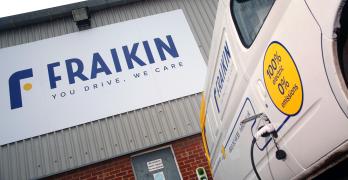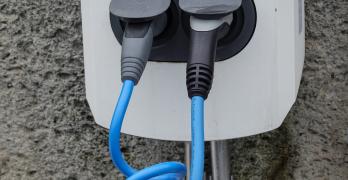Greening the road freight fleet: ecological and economic issues
- 08/12/22
- 6 min
Forget the diesel or petrol vehicle, make way for vehicles with a small environmental footprint.
In the face of climate change, it is urgent to adapt our behaviour, and the transition to a cleaner vehicle fleet is an essential lever for professionals.

The Mobility Orientation Law (LOM) of 24 December 2019 has imposed the greening of the fleet of vehicles under 2.6 tonnes for freight transport companies, as follows:
- 10% of the renewal in 2022.
- 20% of renewal in 2024
- 40% of renewal in 2027
- 70% renewal by 2030
The LOM law only requires vehicles weighing 2.6 tonnes or more to comply with these obligations from 1 January 2023, according to this schedule:
- 10% renewal in 2023
- 20% renewal by 2025
- 40% of renewal in 2028
- 70% renewal in 2031
How can we adapt, and what is the point of renewing our vehicles, beyond compliance with the new rules?
Greening your fleet: optimising energy and optimising your fleet
Olivier Dutrech, Director of Innovation at Fraikin, explains that in France, 1,200 vehicles out of a fleet of 36,000 already use alternative energies. For him, “the company’s objective is to be able to renew 100% of its fleet located in the Low Emission Zones by 2024, which will ban the circulation of vehicles with a Crit’Air 2 sticker (particularly diesels).”
Alternative fuels are the main vehicle for change towards a greener fleet but other solutions, linked to diesel, exist where regulations allow.
The first solution may be to rejuvenate diesel vehicles and reduce their environmental impact through optimised fuel consumption.
As Olivier Dutrech explains, it is first of all possible to keep this energy and to modernise one’s vehicles so that they are as non-polluting as possible.
“At Fraikin, we have rejuvenated all the vehicles in the fleet to the maximum. Our diesel engines meet the most recent standards on the market: Euro 5 and, above all, Euro 6″ for years now.
Options can also limit the ecological impact by reducing fuel consumption: robotised gearboxes, electronic throttle, aerodynamic appendages, use of telematics, etc.
It is possible to keep the vehicle with a diesel engine, and invest in alternative fuels, compatible with it: B100 or synthetic fuels HVO, XTL.
The second solution is to do without diesel (bio or not) and to choose other technologies, using other energies.
At Fraikin, this can be achieved through :
- hybrid engines ;
- Natural gas (CNG) in its CNG (compressed natural gas) or LNG (liquefied natural gas) form;
- electricity.
The future of alternative fuels is also, and above all for heavy goods vehicles (the range via battery electricity is limited), hydrogen: in fuel cells, hydrogen, in contact with oxygen from the air, produces electricity. No CO2 emissions: the vehicles only emit water vapour. This logic is virtuous if the energy needed to produce the hydrogen is low-carbon or renewable
Investing in new fuels and new vehicles with optimised energy consumption are essential steps, but they are not the only ones. Better work organisation also contributes to improving air quality: “At Fraikin, we optimise the use of fleets through route management. We use an algorithm to define the most efficient route organisation (number of vehicles, volume and weight transported, as well as distance to be covered) in order to avoid dead kilometres,” says Olivier Dutrech.
The economic benefits of greening its fleet.
While the ecological benefits of switching to greener vehicles are well established, what about the economic benefits?
Attracting new customers and retaining old ones
Offering clean vehicles makes it possible to attract a new clientele. As Olivier Dutrech explains: “We cannot yet speak of a major trend, but several profiles of company directors may feel concerned.”
Four types of customers may be attracted to alternative energy:
- Those who are pro-environment in their positioning and philosophy,
- those that respond to requirements imposed on them by certain markets,
- those who are obliged to comply with the regulations in the EPZs,
- and finally, those who wish to be ahead of the game and seize the opportunity of green transport to differentiate themselves from their colleagues.
The economic advantages are also to be found in the longer term and in loyalty: while “green” transport is bound to become the norm, it allows for a much longer commitment than before in responding to calls for tender. As the technical solutions are equipped with the latest technological developments, they are particularly expensive and require more time to pay off.
Benefit from state aid to green its fleet more quickly
Investing in new engines and new fuels has a cost: the state helps freight companies to do this.
An ecological bonus has been introduced for the purchase or lease of clean vehicles: the amount depends on the price of the vehicle, but is generally 5,000 euros for a van and up to 50,000 euros for a new truck. This bonus can be combined with the bonus for clean energy vehicles, which has been extended until 31 December 2030. A scheme announced by the government at the end of February 2022 mentions aid of up to €150,000 under certain conditions. Finally, parking for clean vehicles may be free in certain municipalities.
Improve company communication: de-demonise the HGV.
Thanks to the energy transition, and the inclusion of heavy goods vehicles in this process, the “truck” is developing a very different image from the one it has had for years. The transport vehicle is becoming a modern, clean, silent vehicle, equipped with the latest technological advances, in tune with the times
The trucks thus become the modern showcase of the professional rental company.
Greening the fleet: some constraints to consider
A fleet is made up of several types of vehicles that meet different needs: today, even if the offer is growing day by day, not all manufacturers offer the equivalent of their complete diesel ranges in alternative energies.
The choice of energy for a vehicle will necessarily depend on the layout of the network.
As Olivier Dutrech explains, “we cannot access all the energies everywhere in France“. Whether on the road or at the customer’s premises, installations are extremely expensive: they can cost from a few thousand euros to hundreds of thousands.
Finally, the cost of greening a fleet of vehicles is also measured in terms of the time spent fuelling/charging the vehicle. An electric vehicle, and especially a heavy goods vehicle, can remain stationary for several hours to be recharged, depending on the capacity of the charging stations. If it is stopped, so is the driver.
Greening the fleet is essential: to comply with the new rules and to face up to the new uses of customers. While this allows the company to renew its image and modernise its fleet, adapting to the new regulations and bearing the resulting constraints also serves to contribute to the fight to improve air quality, and to add its stone to the building of the greatest global challenge of the years to come.
Also worth reading

Tackling common EV misconceptions

Charging stations: how do you choose the right power?

